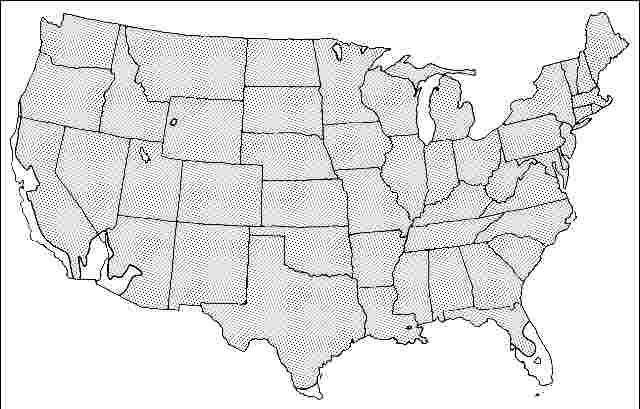Introduction
This shade-tolerant tree slowly grows to 50 feet in height with a 25 to 30-foot spread but is often 25 to 40 feet tall, forming an oval or round canopy. Hophornbeam has a lovely yellow fall color, and the small nutlets, which ripen in summer and fall, are used by birds and mammals during the winter. Bark is an attractive orange or grayish brown peeling off in longitudinal strips. The finely-textured crown casts a medium or dense shade in full sun, but is more open in the shade casting a light shadow.

Credit: Ed Gilman
General Information
Scientific name: Ostrya virginiana
Pronunciation: OSS-tree-uh ver-jin-ee-AY-nuh
Common name(s): American Hophornbeam, Eastern Hophornbeam
Family: Betulaceae
USDA hardiness zones: 3A through 9A (Fig. 2)
Origin: native to North America
Invasive potential: little invasive potential
Uses: container or planter; street without sidewalk; deck or patio; screen; specimen; reclamation; parking lot island < 100 sq ft; parking lot island 100-200 sq ft; parking lot island > 200 sq ft; sidewalk cutout (tree pit); tree lawn 3-4 feet wide; tree lawn 4-6 feet wide; tree lawn > 6 ft wide; urban tolerant; highway median; shade
Availability: somewhat available, may have to go out of the region to find the tree

Description
Height: 30 to 40 feet
Spread: 25 to 30 feet
Crown uniformity: symmetrical
Crown shape: oval, round
Crown density: moderate
Growth rate: slow
Texture: fine
Foliage
Leaf arrangement: alternate (Fig. 3)
Leaf type: simple
Leaf margin: double serrate, serrate
Leaf shape: ovate, elliptic (oval)
Leaf venation: pinnate
Leaf type and persistence: deciduous
Leaf blade length: 2 to 4 inches, 4 to 8 inches
Leaf color: green
Fall color: yellow
Fall characteristic: showy

Flower
Flower color: brown, green
Flower characteristics: showy
Fruit
Fruit shape: elongated
Fruit length: 1 to 3 inches
Fruit covering: dry or hard
Fruit color: green, brown
Fruit characteristics: attracts birds; showy; fruit/leaves not a litter problem
Trunk and Branches
Trunk/bark/branches: branches droop; showy; typically multi-trunked; thorns
Pruning requirement: little required
Breakage: resistant
Current year twig color: brown
Current year twig thickness: thin
Wood specific gravity: unknown
Culture
Light requirement: full sun, partial sun or partial shade, shade tolerant
Soil tolerances: clay; sand; loam; alkaline; acidic; well-drained
Drought tolerance: high
Aerosol salt tolerance: none
Other
Roots: not a problem
Winter interest: yes
Outstanding tree: yes
Ozone sensitivity: tolerant
Verticillium wilt susceptibility: resistant
Pest resistance: free of serious pests and diseases
Use and Management
This is a rugged tree, tolerant of poor soil conditions found in urban areas and should be grown and planted more. Can be purchased as a single or multi-trunked specimen. Multi-stemmed trees have a dramatic impact in the landscape with bright bark and wonderful form. Great for climbing.
Hophornbeam has a shallow root system and will grow in most soils except those that are wet. It is well adapted to downtown city plantings provided soil drainage is good. Often found on dry, rocky slopes with little soil, Hophornbeam is quite tolerant of drought and needs little care once established. Locate it close to people so they can enjoy the wonderful bark and foliage.
Pests
No pests of this tree are usually serious.
Two-lined chestnut borer may infest Hophornbeam. Keep trees healthy by regular fertilization and irrigate soil around tree during drought periods to reduce susceptibility to borer attack.
Scales are usually controlled with horticultural oil.
Basswood leafminer may cause some leafmining damage to foliage.
Orange-humped mapleworm may be found feeding on Ostrya north of Pennsylvania.
Diseases
No diseases of this tree are usually serious.
Canker diseases can cause dieback of individual branches or entire trees. Prune out diseased branches, fertilize regularly, and water during dry weather.
Leaf blister causes blistered or deformed leaves but is not something which needs control.
Leaf spots are generally not serious. Rake up and destroy infected leaves at the end of the growing season, if you wish.
Powdery mildew makes a white coating on the leaves but is otherwise harmless.